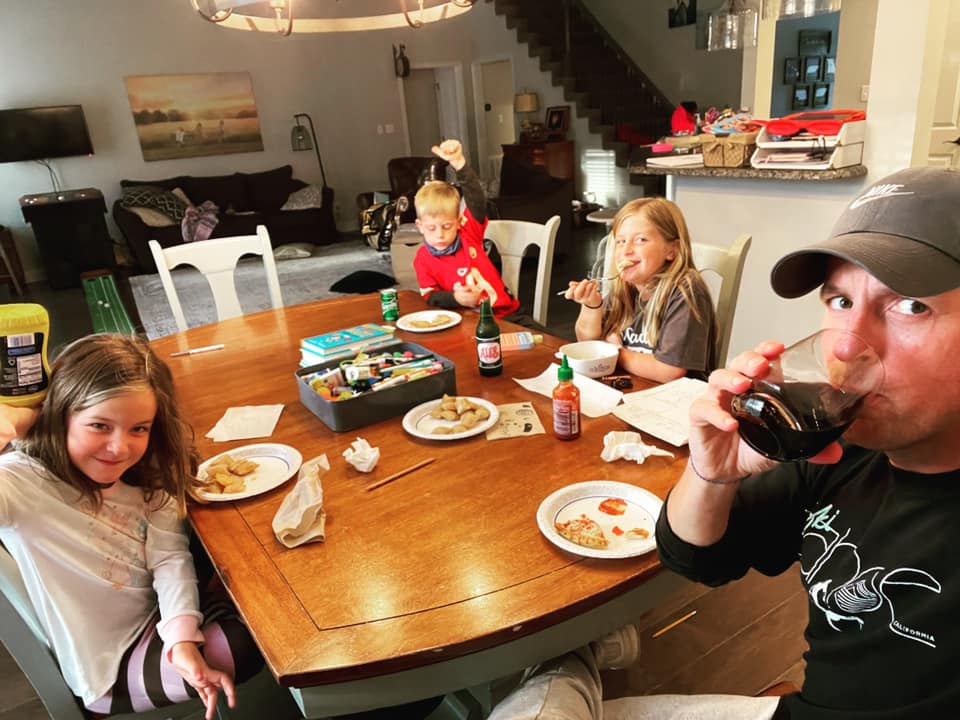You’re talking, but nobody’s listening. You feel like the teacher in that Snoopy cartoon. Waaa -waaa-waaa-waaa-waaa.
You’ve been nice. You’ve been patient. You’ve repeated yourself no less than three times and YOU. ARE. DONE. You think to yourself:
‘Why won’t they just do what I ask them to do?!’
‘I could have never gotten away with this when I was a kid!!!’
‘This is exhausting. Am I the only parent on the planet dealing with this?!’
You feel frustrated, disrespected, and unappreciated, and so the gloves come off as you think to yourself, ‘Nagging, yelling, shaming, bribing. What’s it gonna take to GET THESE KIDS TO LISTEN?!’
Instead of resorting to parenting tactics that leave you feeling guilty and/or disconnected from your child, inspire the listening you are looking for with these five simple strategies:
#1 – Pull for cooperation right from the start.
If you are parenting a strong-willed child, it is likely that each and every time you attempt to exert your authority, your child responds with some sort of resistance. Ignoring you. Defying you. Engaging you with backtalk and banter. Or maybe replying with, “Sure!” just to get you off their case only to ignore you and your request yet again.
Instead of approaching your child with body language that says, “Get your back-side in motion or else!!!” (an understandable stance to take given the past) see if you can strike a team approach that pulls for their cooperation instead.
Stand where you can be seen, heard, and even felt as you gently pat a knee or shoulder. Lock eyes with your child before you speak. Connect. Ensure your child is actually hearing what you are about to say. This means no more yelling “GET YOUR SHOES ON PLEASE, WE ARE LATE!!!” from the next room, even in the kindest or politest of voices. Distant, defensive, or hurried commands invite resistance and set you up to fail before you are even out of the gate.
Once you have your child’s attention, avoid locking horns at the front end and pour on a little honey instead. Avoid words like need, can’t and have to as these “trigger” words do little more than invite pushback and opt instead for words that invite:
- “You need to clean up now.” becomes “It’s time to put the toys up.”
- “You have to come to dinner now.” becomes “It’s time for dinner.”
- “You can’t play anymore right now we need to eat.” becomes “You can play some more after dinner.”

# 2 – Change your method, respond rather than react.
Once your “invitation” is out there, if your child still resists you, instead of reacting to what feels like disobedience, reclaim your personal power and respond to your child instead. As much as pushback can feel like a) a personal attack, b) an elaborate plot to drive you batty, and/or c) a sign of some huge personality flaw in your child that will only get worse with time and needs to be broken, it is more than likely simply r-e-s-i-s-t-a-n-c-e. Resistance to change. Resistance to being told. Resistance to some unknown next thing. Resistance to stop using the brain cells that are currently firing within his or her head to find and engage some whole other set of brain cells necessary to make your request, no matter how valid it is, happen.
Once you let go of your reaction (i.e. feeling shocked, offended, disrespected, etc), you can put 100% of your energy into responding to your child instead (i.e. connecting and redirecting their behavior.)
In my six-hour positive parenting class, we spend two hours talking about this step alone. It’s no small thing to respond rather than react when you feel angry or irritated, but staying calm means everything when it comes to leading and guiding by example. Instead of parenting from fear, shame, and/or other types of coercive power, when you re-focus your efforts on responding to what feels like misbehavior instead of reacting, you’ll find you are 110% more effective at enrolling your child into the very thing you are wanting. Being kind, respectful, and responsible.
Discipline, born of the root word “disciple” which means to lead and guide by example, is a vital part of positive parenting – parenting from a clear, firm, and consistent love. Responding instead of reacting to your child does not mean you are being permissive. It means you are being both firm and respectful as you teach your child what is expected of them at that moment.

# 3 – Restate what you hear your child saying with love.
Use a calm voice as you re-direct your child. I call this my “Siri” voice as Siri never yells at me or makes me feel guilty when I miss a turn. She simply redirects me. “Turn left at the next stop.” Drop any judgment or irritation you might be feeling at your child’s resistance (“justified” irritation on your part, but an irritation nonetheless) from your words and your voice as you report only the facts:
- “You like playing with your Legos.”
- “You are having fun.”
Look for the feeling your child is struggling with and state it calmly as well, with as much empathy as you can muster. Make eye contact as you get down on your child’s level and say:
- “I hear you. You are sad and wish you could keep playing Legos.”
- “You are mad and want to play more.”
This restating, or what I like to think of as empathy, works great with teens as well, though obviously the words and the situations would change. The key here is when you pause to restate what you hear your child saying (or think they might be saying/feeling) it’s like you’re hitting some big cosmic pause button on any old knee-jerk reaction type tendencies you might want to default to and instead, you are offering empathy. A single, well-placed kind word or a hug can be a complete game-changer when it comes to transforming resistance.
Simply put, empathy has the power to create cooperation. By helping your child feel heard, you are helping them to listen.
# 4 – Now that you have your child's calm attention, it's time to restate what YOU are asking for.
Use simple words that invite action. The more specific, concrete, and actionable, the better:
- “It’s time for dinner. Take my hand and we can walk to the table. We can play with Legos when we are done.”
Paint an inviting picture for your child, one they see themselves doing in their head, and avoid the trap of telling them exactly what you do NOT want them to do.
- “Bye-bye Legos. We’ll see you after dinner” for the 2-3-year-old.
- “Let’s hit the pause button (as you hit an imaginary pause button and invite them to do so as well) and we’ll come back to these Legos after dinner.” For the 4-5-year-old.
- “Time for dinner, let’s go. What will you eat first?” or any number of other enrolling questions you think of to get your 5+ older child thinking about the action you are asking of them.

# 5 – Stay with it.
The last element to getting your child to listen is consistency. Once you’ve tasted the sweet success of redirecting resistance without the need to yell, it’s just that much easier to inspire cooperation from your child the next time. And though the transition from your old way of “inspiring listening” to this new way might be a bit more complex than the examples above… STAY WITH IT.
If you and your child are in a dance, resisting one another in the same area of life, over and over, talk about your dance when the situation is not up in your face; the following afternoon for instance. You might open with something like, “Hey, I’ve noticed getting to the dinner table is always a battle for us. What can we do to fix this so we can BOTH feel good in the end? We’re on the same team and I want you to like whatever plan we come up with. Do you have any ideas?” … and then LISTEN. Write down every idea your child has, even the crazy ones:
- “I know. I get a piece of candy every time I come right to the dinner table.”(yeah, right)
- “I’ve GOT IT! We could get a new puppy if we all listen to you and come to the table right away every night for a week!” (not on your life)
You get the idea. Write each one down with a smile, throwing in your own ideas here and there. Allowing for your child’s silly ideas as you make this list is a big part of making this brainstorming session work, especially for kids aged 3 to 9. Heck – everybody likes to laugh and crazy ideas help keep things light. Have fun with it and throw in a few wacko ideas yourself! In the end, find an idea you both like and circle it. You have a winner! When allowed to be a part of creating the solution, even at age 3, your child will be that much more invested in having this solution work.
Putting all five strategies in motion.
Here’s an example of some “listening” a family I’ve been working with privately created. They had been battling their five-year-old son who had been putting his feet up on the table every night, without fail, at dinnertime for what felt like an eternity. Mom’s gentle reminders fell on deaf ears. Repeating and reminding gave way to frustration and anger.
Not only was dinner NOT finding its way into their three children’s little mouths due to all the unrest at the table, but mom and dad’s goal for dinner to be “a peaceful time to reconnect and share about our day over a healthy meal” (a meal mom had just spent over an hour making) was going up in smoke every night. Even the playful ideas mom had tried to make mealtime “fun” for her son and keep him cooperative and at the table failed to keep his feet off the table and all the “fun” was quickly becoming more of a chore than an assist.
That’s when this family followed this five-step plan above and hit the reset button.
The couple got clear about how they were feeling in the face of all this "not listening" and owned their triggers. They canceled their goal to control their son and set a new goal to be clear and respectful as they held to their boundaries. As soon as the goal to control their son was clear, a new space emerged and a new goal --- to own their feelings and to involve their son in the process.
This mom decided to ask her son to help her create a solution. She approached the issue as a team, from her “center” and in a calm moment the following afternoon. She recapped the issue and her goal, free from “trigger” words, and asked her son for ideas. She listened and wrote everything he offered in the way of a solution down. Through this process, she felt calm, connected, and on the same page as her son even as they discussed the behavior that had been driving her up a wall for weeks.
In the end, here’s the gem of an idea her son came up with:

He decided if he put a long strip of paper with “x’s” all along the edge and taped it to the table, he would remember to keep his feet down.
And wha-laa. It was that SIMPLE… and it worked.
He listened that night, and the next, and the next, following the family rule to keep his feet under (instead of on) the table because of a solution he helped to craft. And he continues to follow this rule today, no sticky notes required; nightly battle transformed.

Where could you and your family use a breakthrough toward more listening? I’d love to hear if and how you put these five strategies to the test and what you create with your family. Together.
xo

Mom of four, author, and parent educator Suzanne Tucker is the founder of Generation Mindful, a line of educational tools, toys, and online programs committed to connecting the generations playfully and nurturing the human spirit.
_____________
Generation Mindful creates tools, toys, and programs that nurture emotional intelligence through child-led play and positive parenting. Join us and receive joy in your inbox each week.

























